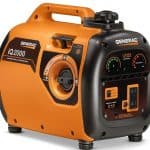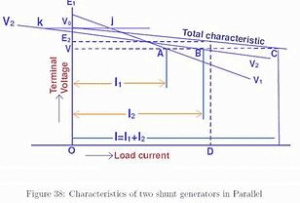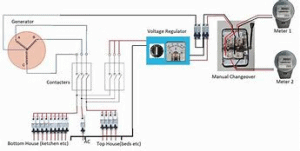Connecting two generators in parallel helps increase the capacity of power supplied and also eases maintenance, control in the management of load and ease redundancy.
The paralleling process entails connecting two or plus generators physically then synchronizing of the two generators’ outputs.
The conducted synchronization works by matching the waveform of one generator output voltage with the other generator’s voltage waveform.
Before connecting two generators parallel, the factors considered include capacity, redundancy, and compliance as per operation, protection, and safety.
Parallel Generators

Generators are great for getting power, but the truth is that sometimes they just do not generate the needed amount of power.
Luckily, you can actually troubleshoot this particular issue by employing parallel generators.
You may not have heard of this method before and that is perfectly fine as we are going to give you a rundown as to what and how exactly it works.
More About Parallel Generators
The most straightforward strategy to course of action a parallel generator structure is to use generators that are really unclear, or if nothing else have a comparable yield rating and alternator pitch.
Another versatile method to manage backing up your ability essentials is to have at any rate two generators of variable yield.
In either circumstance, these can be related in parallel generator with paralleling generator switchgear to achieve the most prominent return during top need or the perfect immaterial recovery during various events — preferences of parallel generator power age structures.
Parallel generator saves control systems have reliably been on a fundamental level valuable over single enormous generator units.
In any case, execution of such structures has commonly been confined to massive exercises or vital applications as a result of the goals of more prominent cost, space, and the raised degree of complexity required to game plan and keep up.
Starting not very far in the past, various associations, both enormous and little, have quit parallel generator action of generator sets.
With the introduction of cutting edge consolidated electronic control progresses, it has now gotten significantly more straightforward to work systems in parallel generator and a bit of leeway from the extra right conditions these structures can give.
Below are some of the generators with parallel capability
| Image | Name | Price | Key Features | Power (Watts) | Carb. Approved | Type | Parallel Capability |
|---|---|---|---|---|---|---|---|
 | Honda EU1000i | Read Full Review | Inverter Generator, Super Quiet with parallel capability... | 1000 | No | Easy to carry | Yes |
 | Honda EU2200i | Read Full Review | 2200-Watt Super Quiet Gas Power Portable Inverter Generator | 2200 | No | Easy to carry | Yes |
 | Generac 6866 iQ2000 | Check Price | Super Quiet 1600 Running | 2000 | Yes | easy to carry | Yes |
 | Briggs & Stratton 30651 P2200 | Read Full Review | PowerSmart Series Portable 2200-Watt Inverter Generator with Parallel Capability | 2200 | easy to carry | Yes | |
 | Honda EU3000iS | Gas Powered, Portable Inverter with parallel capability | 2800 | Need Wheels | Yes | ||
 | Champion 3400 | Check Price | Dual Fuel RV Inverter Generator with Electric Start | 3400 | Portable | Yes |
What is a parallel generator?
A parallel generator is simply the act of combining two small generators together in parallel in an effort to produce as much power as a bigger generator.
Large generators are great and will provide you with the needed power, but they are not at all easy to move and simply not as easy to transport.
It is also much cheaper to simply purchase two smaller units rather than shelling out an abundance of cash for a larger generator that will cost quite a bit.
Can you run two generators in parallel?

Running generators in parallel or rather paralleling generators means connecting two most at times the same size and brand generators together so as to offer double power.
It is possible therefore to run two generators parallel and the connection works to boost the number of watts going either to your RV or home depending on where the generator is been used.
The connection as well increases the supply of power enabling running of plus the necessities run by one generator.
Most users who prefer connecting generators in parallel are ones using appliances such as air conditioners among other appliances that draw larger amounts of power.
Why generators are connected in parallel?

More often, one generator is very enough to supply power to run the necessities in your house for some time.
However, the current world is in much demand for more power from the technology advancement whereby new appliances that need a lot of power are being innovated each day.
Therefore, the inverter generators end up running short of power hence not supplying intended power.
This is much experienced when it comes to power things like the AC unit while traveling or even RV.
For such power demands, there calls much need to use two generators in parallel.
What is the load sharing of a generator?

Load sharing refers to the proportional division of kVAR and kW total load which is between many generator sets of a system in parallel.
Load sharing helps avoid stability problems and overloading problems on the generator sets systems.
When two generators are operating in parallel, the speed governor of the engine of every generator determines the proportional share of active power required by the system.
To achieve kW load sharing, you either decrease or increase fuel to the engine of the system.
How many watts does a camper air conditioner use?

Different air conditioners in camper vans consume different watts of power.
The difference depends on aspects such as AC BTU rating.
BTU is a unit used in Britain to measure thermal energy. Normally, air conditioners have two-watt ratings.
These are, watts needed for startup and the watts needed for running the air conditioner.
The startup watts are normally higher than the running watts.
Therefore, the generator to use for running camper van air conditioner needs to have more watts than the watts needed for startup by the RV.
Below is a list of various air conditions as per BTU ratings and estimated watts for startups and running the AC:
1. Air conditioner 15,000 BTU needs approximately 3200 to 3500 star up watts and 1200 to 1700 running watts
2. Air conditioner 13,500 BTU needs approximately 2700 to 2900 startup watts and 100 to 1300 running watts.
3. Air conditioner 10,000 BTU needs approximately 1900 to 2050 startup watts and 600 to 750 running watts
4. Air conditioner 7000 BTU needs approximately 1600 to 1800 startup watts and 500 to 650 running watts
5. Air conditioner 5000 BTU needs approximately 1100 to 1300 startup watts and 300 to 450 running watts
How to parallel two inverter generators

Inverter generators make the best option when it comes to parallel generators.
This is because the inverter generators have major benefits which include:
- The ability to be run parallel hence increased power
- Fuel-efficient
- Very portable as they are lightweight
- The generators run quietly without any disturbance
- During their usage, most of the inverter generators offer an eco mode for variation of throttle power
Can you parallel two different generators, two different brand generators or two different size generators?
It is very possible to parallel anything with anything provided the frequency and voltage at the connection point is the same.
For generator sets to be compatible with running in parallel, they must have either:
- Compatible alternators
- Compatible engines
- Also, compatible interfaces to control and monitoring systems
- Compatible control systems when it comes to loading sharing
Generators running in parallel need to have a way of sharing load such that they are no case of underloading or overloading.
There are two commonly used ways of load sharing; isochronous and droop load sharing.
Droop is among the simplest to use as it allows generators that are not similar either by brand or size to be used parallel although a major throwback of the method is the fact that they have a wider variety of voltage and frequency levels.
With isochronous, the load sharing is equal and therefore requires the generators in use to have control systems which are common for proper load sharing.
Can you parallel two different brand inverter generators
A general question that many generator sales professionals receive is whether or not it is possible to parallel two non-inverter generators of different make.
best parallel generator kit on AmazonIf you already purchased one non-inverter generator and you need to double the power using a second generator, making sure that this will be safe for the original generator is paramount.
For running appliances like an RV air-conditioning unit, you’re going to need to upgrade your power.
Using two smaller portable non-inverter generators can help save on carrying space and give you customizable power options.
It can be safe to run two non-inverter generators of different models in Parallel.
When adding a second generator, to maximize efficiency, it’s essential to consider the compatibility between two generators.
How to improve compatibility before choosing to parallel to non-inverter generators:
Check load sharing:
The outputs on both generators should be adjusted to be the same. Monitor the speed or bus voltage on both generators to balance the production if possible.
This will make sure that one generator is not doing more of the work.
Compatible alternators:
A mismatch between frequencies in the generator can cause an effect known as motoring which can overload the distribution system and generator when you hook them up.
Most manufacturers will list alternator compatibility on their website or in the instruction manual.
Compatible engines:
If you have two generators that have roughly the same engine capacity or the ability to adjust the capacity to the equal kilowatt value, this can massively improve efficiency.
Getting the right Adapter cable:
To properly parallel to non-inverter generators of different manufacturers, you may need to rely on adapter cables.
Companion kits are available for each manufacturer, or you can consider picking up your adapters for the process.
Overall the process of paralleling non-inverter generators can be completed safely if you follow the steps and check to make sure the system is running efficiently with the load distributed amongst both generators.
Can you parallel two different size generators
Although car batteries are a good way to charge up small appliances, such as phones, if you need a more powerful set up then a portable generator is your best option.
However, if you need more power than one generator can sustain then you can always parallel them.
‘Paralleling two generators’ means that you connect both the generators up together in order to get twice the power as one. It’s a safe and easy way to get more power, wherever you are. Check out best generator deals on Amazon
By using this method you can produce a higher amount of Wattage. This is a great option for people using RVs, mobile homes or even on extended camping trips.
You can also pair your generator with solar power generating devices (such as panels) to boost your power sources. This is a particularly good option in hot and dry climates and it will also save you money on fuel.
You can connect up to any generators, even if they are different sizes and brands, provided that at the point of connection the voltage and frequency are the same.
Benefits of connecting two generators in Parallel
There are several benefits of using two generators in parallel rather than buying one larger one.
It gives you greater reliability. If one of the generators breaks down you will still have at least one as a backup for your power needs.
If you had only been relying on one larger generator and it broke down you would be stuck without power.
Using generators in parallel certainly gives you greater flexibility.
When you need less power you simply use one, and when you need more power you can connect them up. This will also help you save fuel.
Using generators in parallel makes it easier for you to service your set up.
You can remove one from the system and service it while still getting power from the other.
To sum up this section, you can 100% run generators in parallel and doing so has many advantages, both in terms of convenience, reliability, and flexibility.
Does paralleling generators damage those generators?
Generators that are designed so as to be parallel cannot be affected by paralleling.
The generators are safe provided the instructions given by the manufacturer are followed, the right cables used as well as ensuring that those generators using for running parallel are compatible.
Will running my generators in parallel cause any damage?
Typically one will not see any damage from simply running their generators in parallel. An abundance of generators is actually designed to be paralleled.
It is of utmost importance that one follows all of the directions though as that is where things can start to get a bit dangerous if not done correctly.
The biggest thing you will want to do is ensure that the generators that you have are well suited to work together,
Why parallel generators and not buy one large generator?

The most obvious reason as to why anyone would not go for the idea to purchase a new larger generator is because they might be in possession of an inverter generator already but then notice it’s giving less power than desired.
For such a reason, the owner would purchase another inverter generator and parallel the two.
Another reason why the running in parallel of inverter generators is an option is that the generators are quieter and more fuel-efficient compared to the large-sized single generators.
Another reason why the running in parallel of inverter generators is an option is that the generators are quieter and more fuel-efficient compared to the large-sized single generators.
Also, with two generators, you are assured of backup and especially if one of the generators fails unlike when using a single generator.
How to connect two generators in parallel (step by step)
You must be wondering how to connect two generators in parallel (step by step). While connecting two different generators with a similar phase difference, voltage, and frequency, care is highly regarded.
The generators are often combined with increasing the overall performance. The method of connecting two different generators is, in other terms, referred to as parallel.
Besides, the process applied in connecting is referred to as synchronizing.
It is the best way of increasing the plant’s overall power with better ease and control of power.
It assists in performing jobs without the use of money. The method is usually used when power demand is of great need to even higher points.
To succeed in the synchronizing of two kinds of generators, the output waveform needs to be matching with the other generator.
The process is usually done with the use of dark or synchroscope and brighter lamp methods.
For better safety, there is a necessity of keeping the income generator at a more frequency level.
A generator that has already been connected to a bus is referred to as running the generator. Besides, the generator is the need of synchronization for it to be connected, referred to as the incoming generator.
The frequency of a generator ends up slightly reducing when in an active load. Therefore, more frequency assists in avoiding running similarly as a synchronous motor.
More also, a generator is usually connected to a given bus bar in the stationary condition.
Synchronizing of 3 Phase Generators Using Synchroscope
Most of the modern control panels on large industries have a facility that assists in paralleling them automatically.
However, there is a necessity of understanding the manual way as the automatic way may, at times, fail.
Synchroscope is the main item used in measuring synchronization degree. It assists in the closing of the breaker at the appropriate time.
Besides, it helps in representing the speed of machinery with the aid of the pointer. While moving anticlockwise, there is less speed from the incoming generator.
Start on the incoming generator, and by increasing speed, warm it up. This will assist it in a meeting of necessary operational frequency.
Have a close look at the control panel when the incoming generator has the same frequency and voltage similar to that of the bus-bar.
Ensure the two generators you are using have similar phase sequence.
Necessarily adjustments should be put into place if necessary with the aim of getting identical voltage, phase, and frequency sequence.
By switching on the synchroscope, make sure you are monitoring the movement of the pointer.
When the pointer is moving in an anticlockwise way, ensure you increase its speed. When moving fast along the clockwise direction, then consider reducing the rate of the alternator.
Always be keen on ensuring the incoming generator speed is still higher compares to loads speed. Through this, the pointer will be moving in a clockwise way very slowly.
Ensure you are paying attention in engaging the breaker before the pointer gets to reach midnight. It will be the time when the incoming generator will be in a similar phase with the bus bar.
When you are done, it will be upon you to determine whether you will be requiring both generators on weight or require shutting down the generator, which is running.
The task will end up being achieved through the lowering of the governor switch for the generator, which is running and at the same time, increasing for the incoming generator.
Make sure you have switched off the synchroscopes you are using.
Ensure your trip of switch off the breaker of the generator, which is running. By following these steps, the generator shall be standby for use.
To sum up this section, two or even more, generators are run in apparel in power plants, industries, and ships to share the load.
Besides, two generators are used for increasing power output, providing maintenance ease and reduce g of operational cost.
A generator will be run in a parallel way to come up with load sharing and proper synchronization.
However, most generator panels are in either control or local room with a synchronization facility, which is automatic.
Frequency is highly put into consideration for a great smooth in the paralleling of the generator.
Besides, phase angle, voltage, and frequency are highly considered in connection with two different generators.
Synchronization of a generator to another generator can be done using a dark lamp or synchroscope.
Parallel Ready Generators
Parallel ready generators are utilized to change the electrical control to an alternative structure. This may be mechanical vitality or even an alternative sort of force.
A parallel ready-made generator controls an electric charge to travel through an external circuit without creating power or charge.
It takes after a water siphon, creating a development of water. However, it doesn’t transfer water in.
There are various sorts of parallel ready generators available, and a couple of the most widely recognized kinds are oil and diesel.
Parallel ready generators get an electric generator along with a motor that is fitted together to frame one bit of hardware.
In addition to the motor and alternator, the parallel ready generators have fuel supply, a fixed motor speed regulator, cooling and exhaust frames, and a lubricating frame.
Parallel ready generators can be associated electronically through synchronization.
This alludes to a strategy that includes matching the voltage, recurrence, and phase before associating the generator to the immediate transfer tape.
This can be done automatically by the Auto Sync module. The download can be shared between parallel starters through the download share.
Since the main motor of a parallel ready-made generator runs at a constant speed, it will take more load when the fuel supply increases. The load will be released if the fuel supply falls.
Conclusion
Most people who are referring to running generators in parallel are because of a need for more power especially to run camper vans AC which cannot be run by one generator.
Although it is known that gas portable generators are the most versatile sources of power and more fuel-efficient, many of them cannot start then run air conditioners currently fitted in RV of 15,000BTU. Check out Honda 2200i generators that are perfect for parallel.
Paralleling generators, however, can now easily achieve this.
With paralleling, the biggest caution to take is to ensure that the generators are compatible and use the certain cable which should be used for running in parallel.
Note: Read carefully the manual’s instructions of your generator and ask the help from an expert if you are not sure. You can find the most reputable generator brands’ manuals here.
